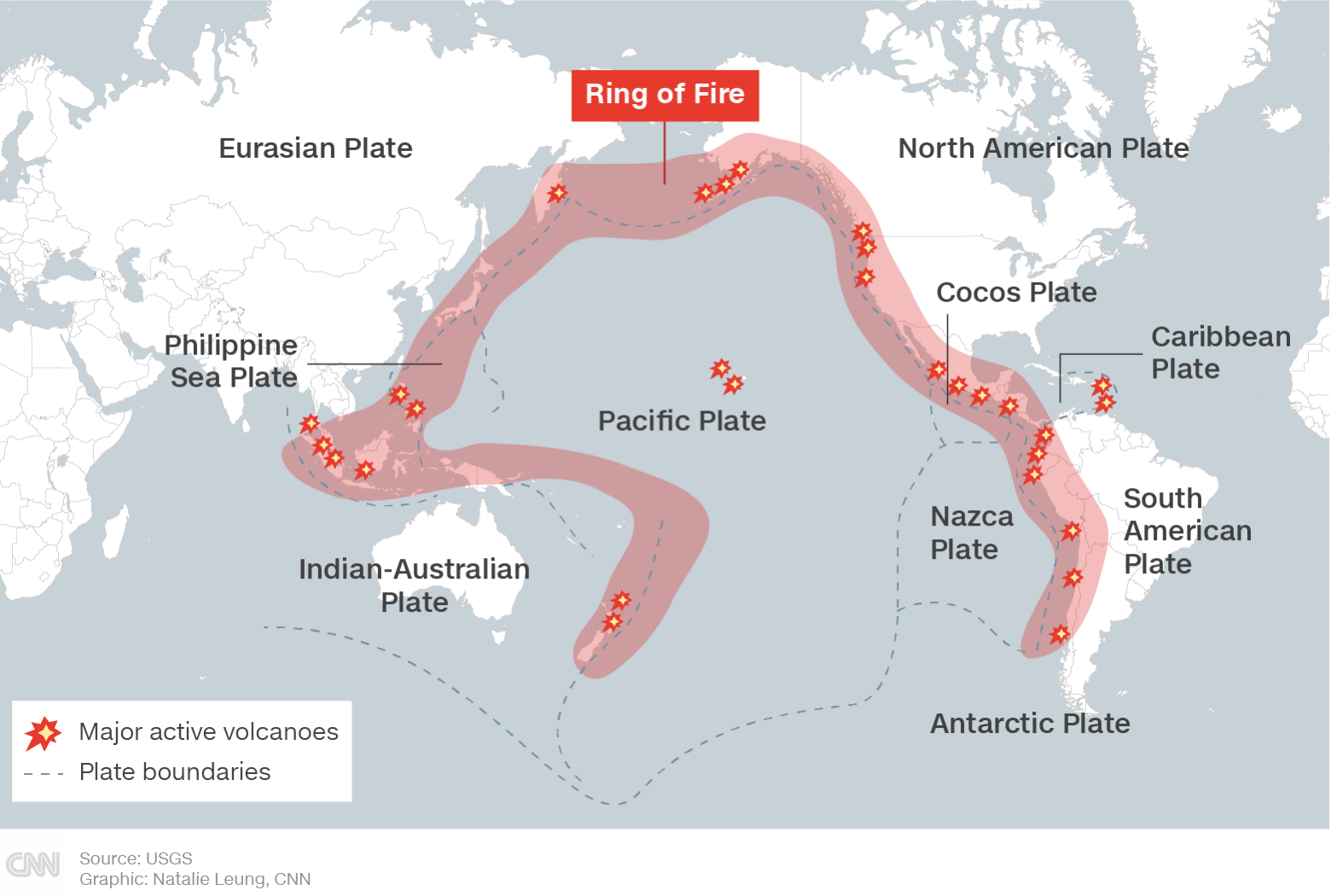Situated on the Pacific Ring of Fire, the Taal volcano (which is identified as a caldera), erupted in the Luzon Island in the Philippines and created a beautiful display of lightning in the process. It remained at level 4 after its phreatic eruption on the 12th of January 2:30 PM for some time. Scientists believe if subsequent eruptions occur, this may plunge the Philippines into a volcanic winter.
But, what does all that even mean?
Let’s break it down.
Pacific Ring of Fire and the Cause of its Eruption
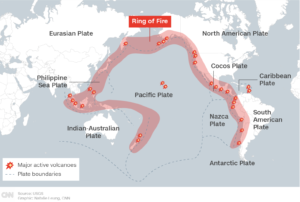
The ring of fire is a path along the Pacific Ocean where earthquakes and volcanoes frequently occur. As most of us are aware, it is theorised that the Earth’s lithosphere is split up into plates that move (very slowly over significant periods) relative to each other. Tectonic plates can either move towards each other, away from each other or slide past each other.
The Taal Eruption occured when two plates moved towards each other (this is called a convergent plate boundary). When they met, the Philippine sea plate (the heavier oceanic crust) subducted underneath the Eurasian plate (continental crust). The Philippines sea plate contains a large amount of surface water and hydrated minerals, so as it sinks to a greater depth and meets greater temperatures and pressure, water is released, which lowers the melting point of the mantle, thus it melts forming magma. The magma rises and is released during a volcanic eruption.
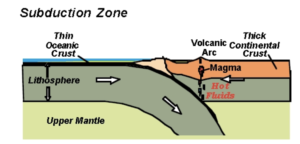
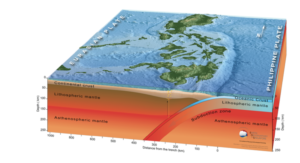
Caldera & The Phreatic Eruption
The Taal volcano is considered a caldera. The diagrams below can be used to illustrate the meaning of a caldera.
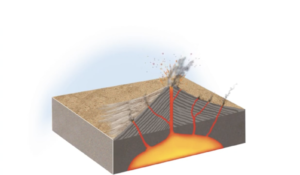
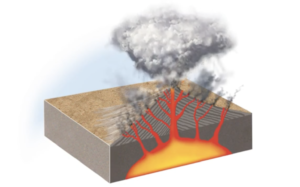
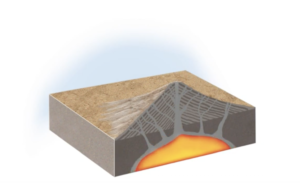
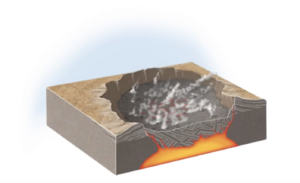
When a volcano erupts to the point where the magma chamber is emptied, the volcano that was above the magma chamber collapses forming a large circular hollow (depression) called a caldera. After periods of rainfall, the caldera may be filled with water forming a crater lake. The Taal Crater Lake’s water (before the eruption) was contaminated with dilute sulfuric acid; however, it is now almost dried up. After the formation of this caldera, which happened between 140,000 and 5,380 BP, subsequent eruptions led to the formation of a volcanic island which has 47 craters and 4 maars.
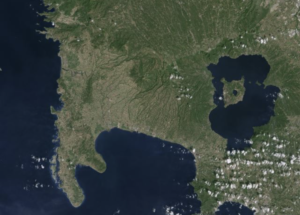
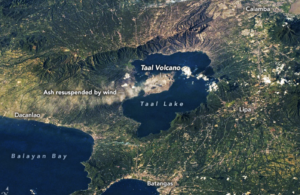
The phreatic nature of the volcano means that the eruption occurs when groundwater or surface water is heated by magma, hot rocks or lava. This heat leads to the water being boiled and producing a steam explosion.
Volcano Alert Levels
Volcanoes are classified as either active, extinct or dormant, but this can be subjective and sometimes, a volcano considered to be extinct can erupt suddenly. Countries have therefore created new classifications to describe the different stages of volcanic activity. It is important to note that different countries use different systems.
The Phillippine Institute of Volcanology and Seismology has created a set of Volcano alert levels to help warn the citizens of the risks involved when volcanoes erupt and provide guidance as to when they should evacuate their homes. Alert levels differ from one volcano to another.
On January 26, 2020, the alert level decreased to 3, but the government warned the citizens to still be cautious and be prepared in case another evacuation is imminent.
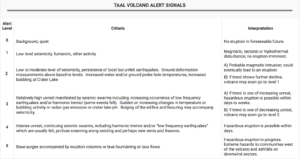
Volcanic Winter
This strange occurrence takes place when volcanic ash and fine sulfur particles dispersed within sulfur dioxide gas (sulfur aerosols) are released from volcanoes. These reach the stratosphere (the second layer of the atmosphere), resulting in global temperatures decreasing. How does this happen? The sulfur aerosols reflect solar radiation coming into the Earth and absorb radiation from the Earth.
A volcanologist at Dension University Erik Klemetti has stated that, as of now, the Taal volcano has not emitted enough sulfur aerosols to impact the global climate. However, if the Taal volcano is to erupt frequently during the next few days, then the possibility of a volcanic winter will increase.
Lightning
Volcanic lightning is not an uncommon phenomenon and has occurred in several volcanic eruptions, including Eyjafjallajökull’s eruption in 2010.
This stunning yet perilous event occurs in the following main steps. Firstly, ash released from the volcano can carry charge, meaning an ash cloud is comprised of positive and negative ions. The different ions can have different charges and differing masses. The positively and negatively charged ions separate due to their relative temperatures and mass, leading to their differing speeds. For example, a smaller ion that has just been released from the volcano would move at a greater speed as it has a higher temperature (therefore greater kinetic energy) compared to a larger ion that has been in the atmosphere for a while. The difference in the size and temperature of the ions means that ions can move vast distances away from each other. When ions are separated, this creates a voltage difference and electricity will flow between these positive and negative ions to neutralise the charge.
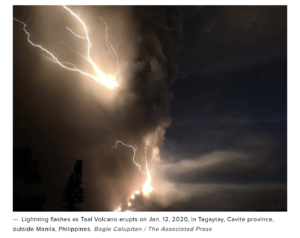
Impact
The Taal’s eruption began with a giant cloud of rock fragment shooting up to 15 kilometres high. Lava was ejected alongside ash, which travelled as far as 70 kilometres away. 46,000 people in the Taal region and provinces nearby had to immediately evacuate, leaving their homes completely covered in ash. According to the Taal Volcano Network, 673 earthquakes were recorded as a result of the eruption. The eruption had drastic consequences which included fish deaths and destroyed pineapple and coffee plantations- 1.5 million dollars of agricultural damage ensued.
A Silver Lining?
The people and government of the Philippines took the horrific incident and innovatively turned it into a positive situation. Instead of disposing of the ash, they collected it and combined it with cement, sand and plastic to create 5,000 bricks per day to rebuild the damaged buildings. Not only are they clearing the roads faster, but they are also reducing their plastic waste. Thus, a catastrophic event was turned into an opportunity for creativity and teamwork, setting an example for the rest of the world.

